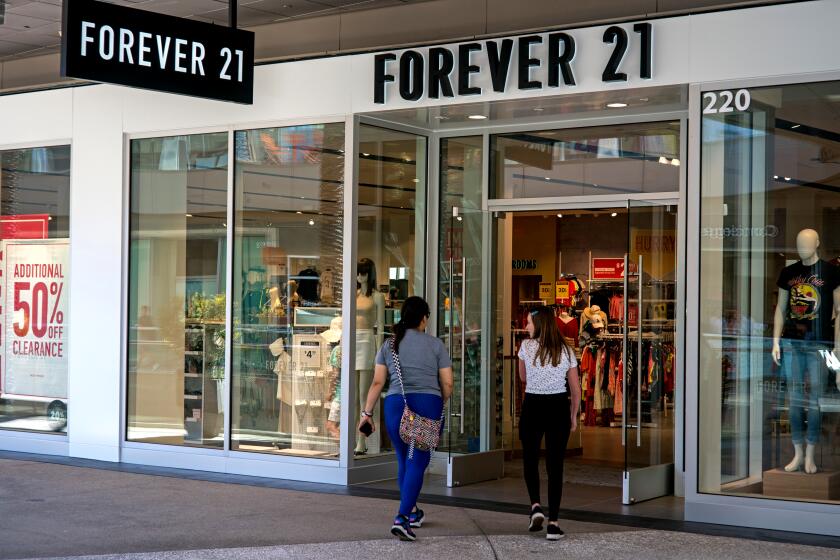Crude Closes Above $50 Mark
- Share via
The price of oil closed above $50 a barrel for the first time Friday, capping months of soaring oil and gasoline prices that have weakened consumers’ spending power and threatened economic growth.
Having eclipsed $50 a barrel several times during intraday trading this week, crude finally ended above that milestone as the forces driving up prices remained firmly in place.
They include strong demand, especially in the United States and Asia; tight supplies globally; real and potential supply disruptions in the Gulf of Mexico, Nigeria and other major oil-production centers; and heavy market speculation by institutional investors.
Crude oil’s rally also has helped lift gasoline prices, with pump prices in Southern California jumping several cents just this week to well above $2 a gallon for self-serve regular.
Oil prices could continue their upward march until there are signs that supplies are swelling or demand is easing, analysts said.
“There is no reason not to believe that higher prices are going to stay,” said Philip McPherson, research director at C.K. Cooper & Co., an Irvine investment firm.
Oil for November delivery jumped 48 cents to $50.12 a barrel on the New York Mercantile Exchange -- its highest close in the 21 years that the futures contract has traded on the Nymex.
This year alone, oil has surged $17.60 a barrel, or 54%, and prices surpassed $50 a barrel less than five months after climbing past the $40-a-barrel mark.
Today’s nominal oil prices remain below their historic peak of the early 1980s, when adjusted for inflation.
Still, lofty energy prices leave fewer dollars for consumers and businesses to spend on other goods and services, raising fears that the U.S. economic expansion could slow.
Spending for “certain things [has] to wait,” Herlinda Santiago, a Wilmington homemaker who drives a Dodge Durango sport utility vehicle, said this week as she shopped at a Target store in Carson.
“Not for the children, but for other things. Home repairs, things like that,” she said.
The average price for regular gas in Los Angeles was $2.151 a gallon Friday, up from $2.081 a week earlier and 10% higher than the $1.953 average at this time last year, according to AAA.
This week’s jump in gas prices also reflects a temporary shortage of Alaskan crude oil -- which provides more than 20% of California’s needs -- and seasonal maintenance at some refineries that has tightened gasoline supplies in the state, Bob van der Valk, bulk fuels manager at Cosby Oil Co. in Santa Fe Springs, said in a note to clients.
Mickey Levy, chief economist at Bank of America, said $50 oil “operates like a tax on consumer purchasing power and also increases businesses’ production costs. In the short run, it probably will have a negative impact” on the economy, he said.
But, he added, “the U.S. economy is very resilient and flexible” and should absorb the shock. “This will be nowhere close to being able to derail the [economic] expansion,” he said.
Few analysts were surprised by oil’s spurt past the $50 mark. They’ve noted all year that the world’s growing thirst for oil had nearly exhausted inventories, leaving little cushion for any supply interruptions and forcing prices higher.
The Organization of the Petroleum Exporting Countries, which supplies about a third of the world’s oil, has boosted production to calm the markets. But most of OPEC’s 11 member nations -- including its largest player, Saudi Arabia -- already are pumping at near capacity.
The threat of civil war in oil-rich Nigeria also is rattling the market. So are production problems in the Gulf of Mexico caused by Hurricane Ivan.
Oil also has rallied this year on other events that threatened production, including fighting and sabotage in Iraq, a tax dispute involving Russia’s largest oil company, a presidential recall vote in Venezuela and terrorism in Saudi Arabia.
*
Times staff writer Ronald D. White contributed to this report.
More to Read
Inside the business of entertainment
The Wide Shot brings you news, analysis and insights on everything from streaming wars to production — and what it all means for the future.
You may occasionally receive promotional content from the Los Angeles Times.











